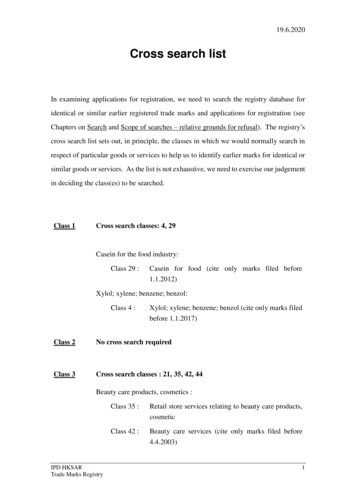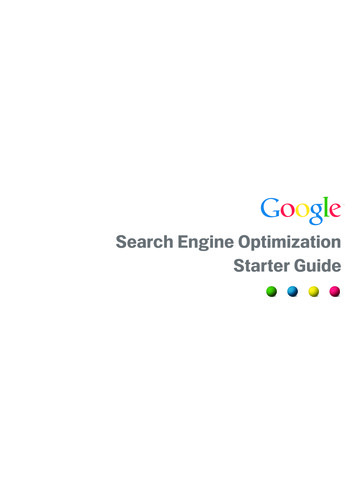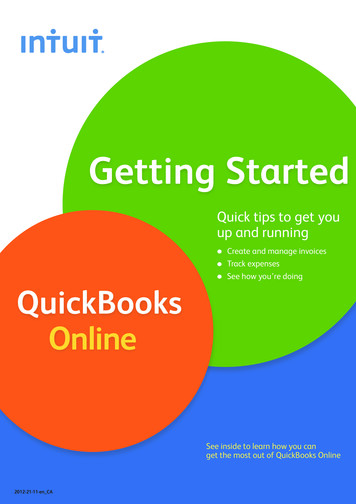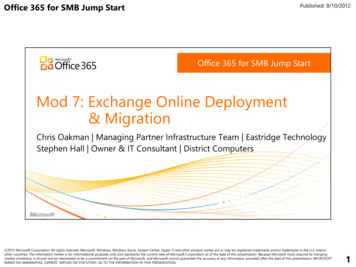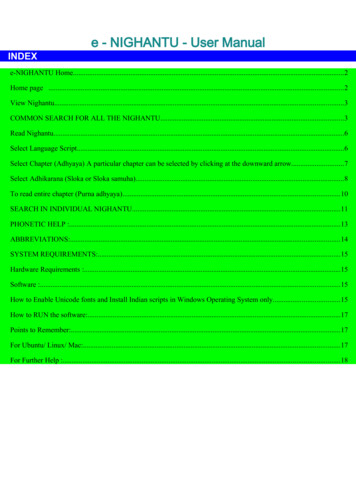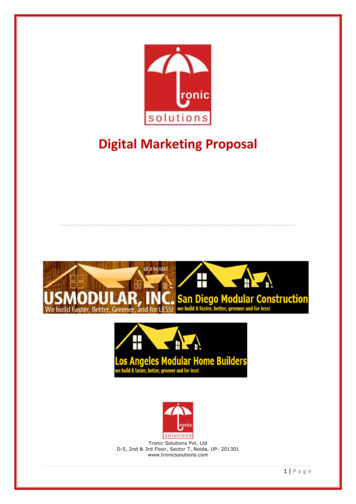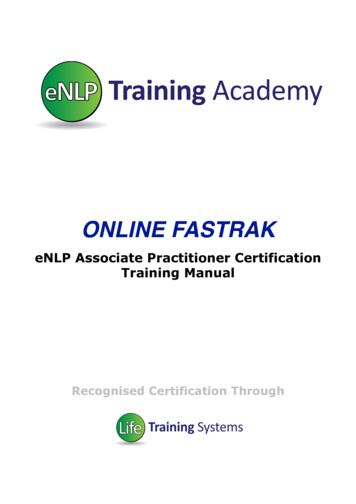
Transcription
ONLINE FASTRAKeNLP Associate Practitioner CertificationTraining ManualRecognised Certification Through
eNLP TRAINING ACADEMY PRACTITIONER MANUAL!1WELCOMEWelcome to the eNLP Practitioner Training. These videos were filmed in a studioto create a personalised training presented directly to you the student, so youare in for an highly educational and enjoyable experience as you go throughthem and learn. As you progress through all of the components of this trainingthere will be exercises I advice you to do the exercises to have a kinaestheticexperience of it before moving onto the next video in the series.Here at the eNLP Training Academy (Life Training Systems Ltd) We are big onsupport so as to ensure your learning is the best that it possibly can be, and tothat end we are available to answer your questions, clarify points, to help youlearn all of the tools, techniques and patterns taught in this online eNLPPractitioner Training, So if you have any questions please either email me or callthe office and I will be happy to answer any of your questions. Call us on 44 1483 243 318 or 44 7904 483 488, or e-mail us at:life@lifetrainingsystems.comIf in the future you would like to upgrade your eNLP Training Academy associateNLP Practitioner certificate to a full Life Training Systems NLP PractitionerCertificate that is recognised by the ABNLP (American Board of NLP) then youwill need to attend one of our one day evaluation days where we can verify thatyou are proficient using these tools and techniques with others to attain thepositive outcome for the client. Please call the office or email me to registeryour interest.Colin C McKayCertified Trainer of NLP, Certified Trainer of Time Line Therapy , CertifiedTrainer of Hypnosis and Clinical Hypnotherapist,Director of Life Training Systems Ltd.eNLP Practitioner Training Manual - Sponsored by Life Training Systems LtdCopyright 2015, Colin C McKay eNLP Training Academy - With thanks to Drs Tad and Adriana James
eNLP TRAINING ACADEMY PRACTITIONER MANUAL!2CONTENTSWelcome .1Contents .2Definition of NLP .4Cause and Effect The Formula for Empowerment .5NLP Communication Model .8Understanding Our Filters .9Perception is Projection .13Five Principles For Success .15Keys To An Achievable Outcome .16Well Formedness Conditions .17The Presuppositions Of NLP .18Prime Directives Of The Unconscious Mind.19Observing Other People .21Rapport .22Representational Systems Preference Test .23Predicates .25List Of Predicate Phrases .26Favored Representational Systems .27Intonation Patterns .28Presuppositions .29The Conscious Use Of Language .32Milton Model .33Hierarchy Of Ideas .39The Meta Model .40Metaphor Outline .42Anchoring.44State Elicitation Script .45Collapse Anchors .46Chaining Anchors .47NLP Change Personal History .48Sub-modalities.49Sub-modalities Like To Dislike Script.50Sub-modalities Belief Change Script .51Sub-modalities Check List .52eNLP Practitioner Training Manual - Sponsored by Life Training Systems LtdCopyright 2015, Colin C McKay eNLP Training Academy - With thanks to Drs Tad and Adriana James
eNLP TRAINING ACADEMY PRACTITIONER MANUAL!3Swish Patterns .55SubModalities Swish Pattern Script .56Dissociative Technique .57Fast Phobia Model .58Eye Pattern Chart .59Eye Pattern Questions .60Strategies Theory .61Strategies Components .62T.O.T.E. Model Of Strategies .63Strategies Structural Well Formedness .64Strategies Elicitation .65Strategies Installing and Changing .66Motivation Strategies .67Learning Strategies .69Spelling Strategies .70Physiology Of Excellence .72Reframing .73Parts Integration .74Steps For Putting A Single Goal In Your Future .75NLP Model of Therapy .76Suggested Family Therapy Model .77The 5 Step Sales Process .79Negotiating—Influencing .82The Meeting Format .86Certification Standards .89NLP Glossary of Terms .91eNLP Practitioner Training Manual - Sponsored by Life Training Systems LtdCopyright 2015, Colin C McKay eNLP Training Academy - With thanks to Drs Tad and Adriana James
eNLP TRAINING ACADEMY PRACTITIONER MANUAL!4The Definition of NLPNeuro:Your neurology or nervous system, the processingunit through which your experiences are processedvia your five senses: Linguistic:Your verbal and nonverbal communication systemsthrough which your internal (neural)representations are processed, filed, coded,ordered and translated into meaning andcommunicated externally through your language. atoryPictures, Sounds, FeelingsTastes and SmellsWords (Self Talk)The conscious and unconscious constructed systemwhich we use to achieve our results. We can easilydiscover and utilise the structure of theseprograms to create and environment of agreementand influence or where necessary we candismantle and re-structure them to create change.Neuro Linguistic Programming (NLP) began as a model of how we communicateto ourselves and others. It was originally developed by Richard Bandler and JohnGrinder and others. This model explains how we internally process theinformation that comes into us from the outside, give meaning to thoseexperiences and then communicate that from the inside to the outside.eNLP Practitioner Training Manual - Sponsored by Life Training Systems LtdCopyright 2015, Colin C McKay eNLP Training Academy - With thanks to Drs Tad and Adriana James
eNLP TRAINING ACADEMY PRACTITIONER MANUAL!5THE FORMULA FOR EMPOWERMENTC EResults- vs -ReasonsBeing At Cause EmpowermentEQUATIONWhich SideAre You On?eNLP Practitioner Training Manual - Sponsored by Life Training Systems LtdCopyright 2015, Colin C McKay eNLP Training Academy - With thanks to Drs Tad and Adriana James
eNLP TRAINING ACADEMY PRACTITIONER MANUAL!6THE CAUSE AND EFFECT EQUATIONThe Cause and Effect equation holds the key to empowerment and the key toyour confidence, control and the development of wisdom.So ask yourself this question.”Which side of the Cause and Effect equationare you on?”To live your life at cause means you are aware that you are at cause for all thathappens in your universe. If perhaps you were suffering from a problem of insome context, to maintain that problem you will be functioning from the effectside of the equation, someone else is doing it to you, maybe the world is doing itto you.In our modern stress laden society it is very common for the bulk of thepopulation to be on the effect side of the equation, most people in our societytoday have given away all of their power and are happy to blame all thathappens in their lives on someone else.The effect side is not an empowering or satisfying side to be on. If the world didit to you today then the world could easily do it to you again tomorrow andwhere is your control in that.I could have been, I would have been, I should have been, but because ofsomething? or someone? I didn’t!!!With this kind thinking you have no control over the problem that you think youare at the effect of. If you are suffering from a problem and you believe it tohave been caused by something or someone else, the tax department, your boss,your parents, a teacher, a friend or maybe your partner did it to you, then youquite simply are given them all of your personal power and denying yourself allof your choices and the wisdom held within the feedback that would resourceyou to take action in a different way.If you push the cause outside of yourself then you are unable to learn. Whenthings are not working for us and life is not how we want it to be, then that isimportant feedback (there is no failure only feedback) and if we can believe thatour focus, beliefs and actions have created the situation then we can take theeNLP Practitioner Training Manual - Sponsored by Life Training Systems LtdCopyright 2015, Colin C McKay eNLP Training Academy - With thanks to Drs Tad and Adriana James
eNLP TRAINING ACADEMY PRACTITIONER MANUAL!7feedback, learn something from it and be empowered to do somethingdifferently tomorrow.As long as you choose to keep living at effect then you are giving away all ofyour power. Move yourself to the cause side of the equation and adopt the beliefthat the sum total of all of your conscious and unconscious actions will createyour future.EXERCISEThis is a fun exercise, from today onward and for the duration of this courseonly!? Cause I’m not telling you must continue to do it this way foreverBut right now just pretend that YOU ARE at cause for everything that happens toyou and I mean everything, so if you are running late because you’re stuck in atraffic jam, ask yourself, ‘for what reason did I choose to create this” if it’sraining and a bus drives through a massive puddle and soaks you, ask yourself,‘for what reason did I choose to create this” if you have no money and the headgasket blows on your car, ask yourself, ‘for what reason did I choose to createthis”This simple shift in your thinking will bring you answers and insights that youhave never had before and I will guarantee you that each time you ask thequestion you will get insights into what you could have done differently thatwould have delivered a far better result. Take the feedback implement a changeand ensure that you create what you WANT in the future.eNLP Practitioner Training Manual - Sponsored by Life Training Systems LtdCopyright 2015, Colin C McKay eNLP Training Academy - With thanks to Drs Tad and Adriana James
eNLP TRAINING ACADEMY PRACTITIONER MANUAL!8THE NLP COMMUNICATION MODELeNLP Practitioner Training Manual - Sponsored by Life Training Systems LtdCopyright 2015, Colin C McKay eNLP Training Academy - With thanks to Drs Tad and Adriana James
eNLP TRAINING ACADEMY PRACTITIONER MANUAL!9UNDERSTANDING OUR FILTERS“The map is not the territory.” the internal representations that we make andthe meaning that we derive about an outside event can never truly be the eventitself.Typically, what happens is that there is an external event and we run that eventthrough our internal processing. We make an Internal Representation (I/R) ofthat event. That I/R of the event combines with a physiology and creates astate. “State” refers to the internal emotional state of the individual – a happystate, a sad state, a motivated state, and so on. Our I/R includes our internalpictures, sounds and dialogue, and our feelings (for example, whether we feelmotivated, challenged, pleased, excited, and so on). A given state is the resultof the combination of an internal representation and a physiology. So whathappens is that an event comes in through our sensory input channels which are: VisualIncluding the sights we see or the way someone looks at us; AuditoryIncluding sounds, the words we hear and the way that people say thosewords to us (unless you specifically want variety in form); KinestheticOr external feelings which include the touch of someone or something, thepressure, and texture; OlfactoryWhich is smell; and GustatoryWhich is taste.The external event comes in through our sensory input channels and it is filteredand we process the event. As we process the event, we delete, distort, andgeneralise the information that comes in, according to any number of elementsthat filter our perception.DELETION:Deletions occur when we selectively pay attention to certain aspects of ourexperience and not others. We will then overlook or omit all of those otherthings from our reality. Without deletion, we would be faced with much toomuch information to handle with our conscious mind.eNLP Practitioner Training Manual - Sponsored by Life Training Systems LtdCopyright 2015, Colin C McKay eNLP Training Academy - With thanks to Drs Tad and Adriana James
eNLP TRAINING ACADEMY PRACTITIONER MANUAL!10DISTORTION:Distortion occurs when we make shifts in our experience of sensory data bymaking misrepresentations of reality.My mother one night when I was young, got up for a glass of water and in thegloom saw a massive scurrying spider, she does not like spiders! She immediatelymade a grab for the telephone book and taking her time to ensure a direct hit ofthis fast moving enormous spider she slammed the telephone book down,pleased with herself that she had managed to secure a direct hit. In the morningwhen I got up, I was curious as to why the telephone book was in the middle ofthe hall floor and upon inspection found it was on top of one of my brothersplastic toy spiders!!? My mother to this day swears that it was moving at pace.GENERALISATION:The third process is generalisation, where we draw global conclusions based onone or two experiences, one thing becomes everything or everything can becomeone thing. At its best, generalisations can be an incredibly good thing, by takingin the information and then drawing broad positive conclusions about themeaning of the effect of those conclusions on us personally.Normally, the conscious mind can only handle 7 (plus or minus 2) chunks ofinformation at any given time. Of course, many people can’t even handle thisnumber, and I know people who are a “1 (Plus or minus 2).” How about you? Trythis: Can you name more than 7 products in a given product category, say softdrinks? Most people will be able to only name 3, maybe 4 products in a categoryof low interest and usually no more than 9 in a category of high interest. Thereis a reason for this. If we didn’t actively delete information all the time, we’dend up with much too much information coming in. In fact, you may have evenheard that psychologists say that if we were simultaneously aware of all of thesensory information that was coming in, we’d go completely mad. That’s why wehave to filter the information.So this is why when two people experience the same stimulus, they don’t havehave the same response? Because they delete, distort, and generalise theinformation from the outside in a completely unique to them way.We as individuals delete, distort and generalise the information that comes infrom our senses through any one of, or all of, five different filters and how thesefilters operate within us is totally unique to the individual. The filters are, MetaPrograms, belief systems, values, decisions, and memories.eNLP Practitioner Training Manual - Sponsored by Life Training Systems LtdCopyright 2015, Colin C McKay eNLP Training Academy - With thanks to Drs Tad and Adriana James
eNLP TRAINING ACADEMY PRACTITIONER MANUAL!11META-PROGRAMS:The first of these filters is Meta Programs. Knowing someone’s Meta Programscan actually help you clearly and closely predict people’s states, and thereforepredict their actions. One important point about Meta Programs: they are notgood or bad, they are just the way someone handles information. We teach MetaPrograms very thoroughly in our live Master Practitioner Training, if you areinterested to read me please read Dr Tad James Time Line Therapy The Basis ofPersonality.VALUES:The next filter is values. They are essentially an evaluation filter. They are howwe decide whether our actions are good or bad, right or wrong. And they arehow we understand and male sense of how we feel about our actions. Values arearranged in a hierarchy with the most important one typically being at the topand lesser ones below that. We all have different models of world (an internalmodel about the world), and our values are the result of our model of the world.When we communicate with ourselves or someone else, if our model of theworld conflicts with our values or their values, then there’s going to be aconflict. Richard Bandler says, “Values are those things we don’t live up to.”Values are what people typically move toward or away from (see MetaPrograms). They are our attractions or repulsion’s in life. They are essentially adeep, unconscious belief system about what’s important and what’s good or badto us. Values change with context too. That is, you probably have certain valuesabout what you want in a relationship and what you want in business. Yourvalues about what you want in one and in the other may be quite different. Andactually, if they’re not, it’s possible that you may have trouble with both. Sincevalues are context related, they may also be state related, although values aredefinitely less related to state than are beliefs.BELIEFS:The next filter is beliefs. Beliefs are generalisations about how the world is. Oneof the important elements in modelling is to find a person’s beliefs about theparticular behaviour we are trying to model. Richard Bandler says “Beliefs arethose things we can’t get around.” Beliefs are the presuppositions that we haveabout the way the world is that either create or deny personal power to us. So,beliefs are essentially our on/off switch for our ability to do anything in theworld. In the process of working with someone’s beliefs, it’s important to elicitor find out what beliefs they have that cause them to do what they do. We alsowant to find out the dis-enabling beliefs, the ones that do not allow them to dowhat they want to do.eNLP Practitioner Training Manual - Sponsored by Life Training Systems LtdCopyright 2015, Colin C McKay eNLP Training Academy - With thanks to Drs Tad and Adriana James
eNLP TRAINING ACADEMY PRACTITIONER MANUAL!12MEMORIES:The fourth element is our memories. In fact, some psychologists believe that aswe get older, our reactions in the present are reactions to gestalts (collections ofmemories which are organised in a certain way) of past memories, and that thepresent plays a very small part in our behaviour.DECISIONS:The fifth element, and related to memories, is decisions that we’ve made in thepast. Decisions may create beliefs, or may just affect our perceptions throughtime. The problem with many decisions is that they were made eitherunconsciously or at a very early age, and are forgotten.These filters will determine our internal representation of an event that isoccurring right now. It is our internal representation that puts us in a certainstate, and creates a certain physiology. The state in which we find ourselves,will determine our behaviour.Remember that in this model the map, the I/R, is not the territory. Our everyexperience is something that we literally makeup inside our heads. We do notexperience reality directly, since we are always deleting, distorting, andgeneralising. Essentially, what we do experience is our experience of theterritory and not the territory itself.NOTE: These notes have been taken directly from our Life Training Systems NLPPractitioner Certification Manual, which is endorsed by the ABNLP and directlybased on the work of Dr’s Tad And Adriana James @ www.NLPcoaching.comeNLP Practitioner Training Manual - Sponsored by Life Training Systems LtdCopyright 2015, Colin C McKay eNLP Training Academy - With thanks to Drs Tad and Adriana James
eNLP TRAINING ACADEMY PRACTITIONER MANUAL!13PERCEPTION IS PROJECTIONPerception is Projection, what does it mean? And how can we change it?As we now understand from the NLP Communication Model, every waking secondof everyday our five senses are bombarded with 2 million bits of information,now you may think, 'that's a lot!" And indeed it is!Though think about it, if you look out of the window into perhaps a garden orwhatever scene you have in front of you, instantly you will see trees, leaves,grass, bushes, people, bricks that make up houses, roof riles and think for amoment as to how many blades of grass are you seeing how many leaves do yousee, how many bricks, you will begin to get an understanding of the vastness ofthe 2 million bits of information every second that are relentlessly coming in toour minds through our highly attuned and evolved senses.Now our brain is incredibly complex and incredibly powerful, but it just can'tcope with 2 million bits of information, all it can handle is approximately 134bits a second or in other words 7 plus or minus 2 chunks of information.The world that we live in, the world that we choose to see is made up of those134 bits, the rest we simply delete, distort and generalise. To make this processeasy on ourselves, the 134 bits that we grab onto every second are the bits thatwe recognise, the bits that we have asked for and this is essentially dictated byour focus.Your unconscious mind is there to serve you and to deliver for you exactly whatyou want. It is scanning and searching every second for a match, information andactions that will deliver you the result that fits with your focus.There is a very important rule that you must be made aware of and that is theunconscious mind doesn't recognise negation, it only goes with your focus!! If Iwas to say to you DON'T THINK of a BLUE TREE, what did you just do? Youthought of a blue tree didn’t even although I told you not to.So if you are habitually focused on what you don't want? Then guess what? Thatwill become the criteria of your focus and in turn the 134 bits of informationthat you choose to grab onto.eNLP Practitioner Training Manual - Sponsored by Life Training Systems LtdCopyright 2015, Colin C McKay eNLP Training Academy - With thanks to Drs Tad and Adriana James
eNLP TRAINING ACADEMY PRACTITIONER MANUAL!14We very effectively deliver ourselves what we BELIEVE our realities to be. AsHenry Ford once put it 'whether you think you can or you think you can't, you’reright"EXERCISEStart to pay attention to the results you are getting and have an honest thinkabout what outcome were you focused on? Was it truly what you wanted or wasit what you didn't want? Allow yourself to have an undeniable experience of thefact that you are simply delivering results based on your beliefs and your focus.With this revelation you will be able to begin to easily police your focus alwaysre-directing it onto what you actually want to happen, over a very short space oftime this will train your mind to be searching with positive focus for all that youwant. There is a very old saying based on this long understood principle, 'seekand ye shall find"eNLP Practitioner Training Manual - Sponsored by Life Training Systems LtdCopyright 2015, Colin C McKay eNLP Training Academy - With thanks to Drs Tad and Adriana James
eNLP TRAINING ACADEMY PRACTITIONER MANUAL!15THE FIVE PRINCIPLES FOR SUCCESS1.Know your outcomeThe first step is to know your outcome, now this is a very specific outcome, you will allknow doubt have heard of or been taught a goal setting model the principle that we teachis based around smart goals, so make the outcome specific and simple, meaningful andmeasurable, as if now and all areas of life, realistic and responsible, toward what youwant and timed.Now having down that you still don’t fully know your outcome, because you have to payattention to how you feel about it, do you believe in it? if you don’t believe in it you willhave to either get a clarity on your doubt that have and deal with it so that it doesn’teffect your perceptions or you can make a smaller incremental goal that is a steppingstone towards this main goal that you can believe in right now.2.Take actionDo something immediately that is going to move you toward your goal.3.Have sensory acuityAs you take action you are going to get feedback, has this action taken me closer to mygoal or not, this is sensory acuity, the important word being sensory. So in the feedbackwhat is real and what is a hallucination? this is where you need to know that you are beingat cause and that you are aware of any possible internal pre conceived perception thatyou may be projecting into your results, from the sensory based feedback you want tothen apply step 44.Have behavioral flexibilityTake the feedback understand that feedback from a sensory based prospective and if youractions are not taking you closer to your goals then hold yourself accountable for doingsomething different that will take you closer to your goal. the law of requisite verity tellsus that the person or the system with the most flexibility will control the system.5.Operate from a physiology and psychology of excellenceAn overriding principle that must be present in all of these steps is that you are operatingfrom a physiology and psychology of excellence. I suppose I better get on with it then, ishardly a dynamic state of being that will guarantee results, is itIf you repeat steps 2 through 5 with consistency, you will end up ultimately at your goal.eNLP Practitioner Training Manual - Sponsored by Life Training Systems LtdCopyright 2015, Colin C McKay eNLP Training Academy - With thanks to Drs Tad and Adriana James
eNLP TRAINING ACADEMY PRACTITIONER MANUAL!16KEYS TO AN ACHIEVABLE OUTCOMEBegin by asking yourself: “How is it possible that they don’t have it now?”1.Stated in the positive.“What specifically do you want?”2.Specify present situation.“Where are you now?” (Associated)3.Specify outcome.“What will you see, hear, feel, etc., when you have it?” As if now. Make compelling Insert in future. Be sure future picture is dissociated.4.Specify evidence procedure.“How will you know when you have it?”5.Is it congruently desirable?“What will this outcome get for you or allow you to do?”6.Is it self-initiated and self-maintained?“Is it only for you?”7.Is it appropriately contextualised?“Where, when, how, and with whom do you want it?”8.What resources are needed?“What do you have now, and what do you need to get your outcome?” “Have you ever had or done this before?” “Do you know anyone who has?” “Can you act as if you have it?”9.Is it ecological? “For what purpose do you want this?” “What will you gain or lose if you have it?” What will happen if you get it? What won’t happen if you get it? What will happen if you don’t get it? What won’t happen if you don’t get it?eNLP Practitioner Training Manual - Sponsored by Life Training Systems LtdCopyright 2015, Colin C McKay eNLP Training Academy - With thanks to Drs Tad and Adriana James
eNLP TRAINING ACADEMY PRACTITIONER MANUAL!17WELL FORMEDNESS CONDITIONSfor Outcomes/Goals1.Stated in positive terms.2.Initiated and maintained by self.3.Specific sensory-based description of outcome and the steps
NLP Practitioner certificate to a full Life Training Systems NLP Practitioner Certificate that is recognised by the ABNLP (American Board of NLP) then you will need to attend one of our one day evaluation days where we can verify that you are proficient using these tools and techniques w
